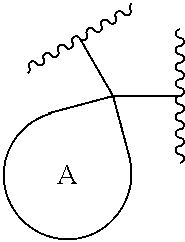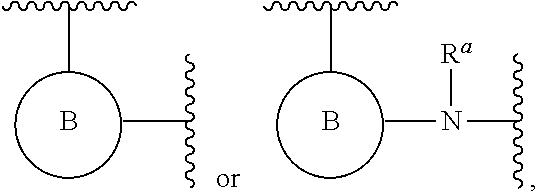Kinase inhibitors
a kinase inhibitor and protein technology, applied in the field of protein kinase inhibitors, can solve the problems of poor prognosis, decreased virus production, and improved 5-year survival, and achieve the effect of improving survival rate and improving prognosis
- Summary
- Abstract
- Description
- Claims
- Application Information
AI Technical Summary
Benefits of technology
Problems solved by technology
Method used
Image
Examples
example 1-1
Preparation of 4-(1-acryloylpiperidin-3-yl)-6,7,8,9-tetrahydro-5H-pyrido[3,4-b]indole-1-carboxamide (Compound 1-1)
[0248]
Step 1: Preparation of 5-bromo-2-chloro-3-hydrazineylpyridine
[0249]A solution of sodium nitrite (6.65 g, 96.41 mmol) in water (70 mL) at 0° C. was added dropwise to a stirred mixture of 5-bromo-2-chloro-pyridin-3-amine (20.0 g, 96.4 mmol) in hydrochloric acid (70 mL, 36-38%). After stirring for 30 min at this temperature, the mixture was added dropwise to a solution of stannous chloride dihydrate (43.51 g, 192.81 mmol) in hydrochloric acid (50 mL, 36-38%) at 0° C. The reaction mixture was stirred for 1 h at 20° C. and then filtered. The isolated solid was washed with hydrochloric acid (50 mL, 36-38%) and dissolved in MeOH (100 mL). The resulting solution was neutralized with saturated aqueous sodium bicarbonate and extracted with ethyl acetate (3×300 mL). The combined organic layers were washed with brine (300 mL), dried over anhydrous sodium sulfate and concentrat...
example 2-1
Preparation of 4-(2-acryloyl-1,2,3,4-tetrahydroisoquinolin-5-yl)-6,7,8,9-tetrahydro-5H-pyrido[3,4-b]indole-1-carboxamide (Compound 2-1)
[0258]
Step 1: Preparation of tert-butyl 5-(1-chloro-6,7,8,9-tetrahydro-5H-pyrido[3,4-b]indol-4-yl)-3,4-dihydroisoquinoline-2(1H)-carboxylate
[0259]A mixture of 4-bromo-1-chloro-6,7,8,9-tetrahydro-5H-pyrido[3,4-b]indole (3.10 g, 10.86 mmol), tert-butyl 5-(4,4,5,5-tetramethyl-1,3,2-dioxaborolan-2-yl)-3,4-dihydro-1H-isoquinoline-2-carboxylate (4.68 g, 13.0 mmol), [1,1′-bis(diphenylphosphino) ferrocene]dichloropalladium(II) (794 mg, 1.09 mmol) and potassium phosphate (6.91 g, 32.5 mmol) in THF (25 mL) and water (2 mL) was degassed and backfilled with nitrogen (×5). The reaction mixture was heated overnight at 60° C. under nitrogen atmosphere. The cooled mixture was diluted with water (100 mL) and extracted with ethyl acetate (50 mL×3). The combined organic layers were washed with water (50 mL) and brine (50 mL), dried over anhydrous sodium sulfate and con...
examples 2-2 to 2-10
[0263]Compounds 2-2 through 2-10 in Table 2, were prepared in a similar manner to compounds 1-1 and 2-1, as described in examples 1 and 2.
TABLE 2COMPOUNDS 2-2 THROUGH 2-10CompoundNo.Structure1H NMR2-2(300 MHz, DMSO-d6) δ 11.23 (s, 1H), 8.13 (s, 1H), 7.95-7.84 (m, 1H), 7.59 (s, 1H), 6.99-6.76 (m, 1H), 6.29-6.06 (m, 1H), 5.88-5.82 (m, 1H), 5.78-5.63 (m, 1H), 4.41-4.20 (m, 2H), 3.82-3.69 (m, 2H), 2.81 (t, J = 5.8 Hz, 2H), 2.70-2.53 (m, 2H), 2.45-2.20 (m, 2H), 1.88-1.63 (m, 4H).2-3(300 MHz, CD3OD) δ 8.07 (s, 1H), 6.95-6.68 (m, 1H), 6.22 (d, J = 16.5 Hz, 1H), 5.82-5.69 (m, 1H), 4.80-4.62 (m, 1H), 4.33-4.15 (m, 1H), 3.57-3.37 (m, 2H), 3.27-3.04 (m, 1H), 2.97-2.78 (m, 4H), 2.22-2.10 (m, 1H), 2.09-1.81 (m, 6H), 1.78-1.63 (m, 1H).2-4(300 MHz, CD3OD) δ 8.07 (s, 1H), 6.93-6.71 (m, 1H), 6.22 (d, J = 16.8 Hz, 1H), 5.84-5.68 (m, 1H), 4.82-4.62 (m, 1H), 4.31-4.14 (m, 1H), 3.58-3.35 (m, 2H), 3.27-3.04 (m, 1H), 3.01-2.79 (m, 4H), 2.22-2.10 (m, 1H), 2.09-1.85 (m, 6H), 1.79-1.60 (m, 1H).2-5(300 MHz, ...
PUM
 Login to View More
Login to View More Abstract
Description
Claims
Application Information
 Login to View More
Login to View More - R&D
- Intellectual Property
- Life Sciences
- Materials
- Tech Scout
- Unparalleled Data Quality
- Higher Quality Content
- 60% Fewer Hallucinations
Browse by: Latest US Patents, China's latest patents, Technical Efficacy Thesaurus, Application Domain, Technology Topic, Popular Technical Reports.
© 2025 PatSnap. All rights reserved.Legal|Privacy policy|Modern Slavery Act Transparency Statement|Sitemap|About US| Contact US: help@patsnap.com



